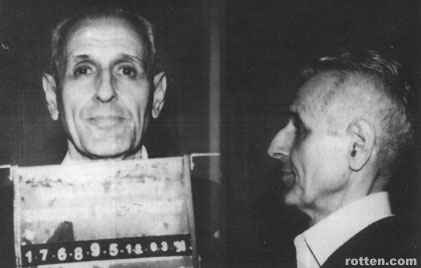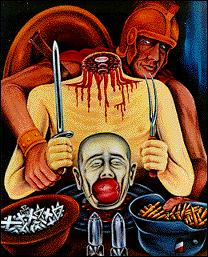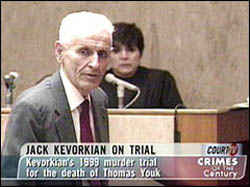|
Dr. Jack KevorkianIts a dirty job, assisting people in committing suicide, but somebody's gotta do it. Well, actually he doesn't gotta do it, but he does it anyway.Dr. Jack Kevorkian emerged in the late 1980s as a hero to all those terminally ill patients who lacked the mental and/or physical stamina to put a shotgun in their mouths or down a bottle of sleeping pills.
Kevorkian started his medical career as a pathologist with a creative flair for morbid but useful ideas, such keeping death row inmates alive but anesthetized, so their organs could be harvested. Later, he campaigned for a public policy encouraging medical experimentation on prison inmates, an odd sort of idea coming from someone who frequently accuses his detractors of being Nazis. Kevorkian put the pathological back in pathology. He earned the nickname of Dr. Death early on in his career, when he performed experiments photographing the eyes of dying people, which he offered as a diagnostic tool for determining whether coma patients were still alive. He was also an advocate of providing transfusions from the recently dead to the living. His medical ideas could certainly be argued on their merits. It was his sociological ideas that presented problems for the masses. After blowing his life savings on a comically failed bid to become a movie producer, Kevorkian returned to medicine, where he became a vocal advocate of euthanasia, the controversial practice of physician-assisted suicide for patients in great pain and the terminally ill. This in itself isnt exactly a reason for hanging. Euthanasia is one of societys great debates. It was his zest for the subject that was unnerving. Kevorkian was really, REALLY in favor of euthanasia. Like some people have an unhealthy love for football or heroin, Kevorkian loved assisting suicides. In 1989, Kevorkian took suicide high-tech with the Thanatron, a suicide machine for the 21st century. The Thanatron removed all the messy brain splatter of a shotgun blast, making suicide as painless as the touch of a button. It was designed so that patients could actually pull the trigger themselves, introducing lethal poison into an IV tube. The basic machine was the kind of thing a 12-year-old could design with a Radio Shack 101 Experiments kit. It was made with $30 worth of spare parts. As with Kevorkians previous ideas, the Thanatron made a certain kind of creepy sense. The doctor didnt actually kill the patient (one major hot point in the euthanasia debate); the doctor simply enabled the patient to do the job.
Kevorkians suicide machine got its first tryout in 1990. The doctor drove the apparatus around in his beat-up old van, quickly dubbed the Deathmobile. A 54-year-old Alzheimers sufferer heard about the Thanatron and managed to remember it long enough to give Kevorkian a call. The assisted suicide was the first in a series. By the time Kevorkian finally got the prison sentence he craved, around 130 people would be helped to their final resting place. While organizations like the American Medical Association tried to have serious and thoughtful discussions about euthanasia, Kevorkian transformed the debate into a combination of circus sideshow and Law and Order episode. Kevorkian embraced the media spectacle with a vengeance, appearing on TV to defend his actions while daring the authorities to try to stop him. He videotaped statements from his victims, and sometimes videotaped the suicides themselves. The authorities dont like being dared to stop things, so they charged Dr. Death with murder immediately following the first suicide. He skated, what with there not being a murder technically. After this success, he struck again, twice in 1991 and several more times in 1992. After a few rounds with his death machine, he switched his M.O. to carbon monoxide poisoning. Considering that it's pretty easy to sit in the garage with the car running, it's not quite clear why someone would need Kevorkian's help with this particular form of suicide, but some people just aren't self-starters. In 1993, Kevorkian assisted a Michigan man in committing suicide in his home, but a controversy erupted. Well, more controversy than usual. Anti-euthanasia activists charged that the man had requested the procedure be halted partway through and accused Kevorkian of altering his record of the procedure. Prosecutors investigated, but didn't find enough grounds for a trial.
Despite this, he was allowed bond in the original suicide, proving once again that the criminal justice system works. He refused to pay his bail, and instead decided to play the martyr, staying in jail and embarking on a hunger strike. This lasted a little less than a month, until his bail was reduced to $100 on the condition that he promise to be good. By spring, Kevorkian had not only been acquitted of the original charge but the entire law was struck down as unconstitutional. Anarchy ensued. Oregon actually legalized the practice (but not for freelancers like Kevorkian), but that law was litigated into the ground. Kevorkian struck again. And again. And again. Kevorkian has been compared to a serial killer. When asked about this in a Vanity Fair interview in 1994, he responded with a horrible pun ("I polished off a box of Cheerios this morning"), proving that while he might be psychotic, he's no Hannibal Lecter in the style department. What started out as a kind of quirky, if morbid, tale of a libertarian bucking the system quickly descended into a morass of conflicting legal decisions and medical ethics dissertations. In other words, it got old fast. Kevorkian kept on "helping people," and endless parades of people who believe their opinions matter wasted oxygen debating the morality of the whole thing. Despite the embarrassing failures of past efforts, prosecutors lined up to try to make Kevorkian pay. Acquittal after acquittal followed. Kevorkian managed to crank his death toll up into three figures before anyone managed to make a charge stick. In at least one case, Kevorkian assisted a non-terminal patient in suicide, in another the patient's mental state was questionable, all of which sparked more and more tedious haggling over the details of how assisted suicide should work, if it were to work. (Probably the best argument against allowing assisted suicide is that abandoning the notion would possibly spare us all having to hear it all again and again.) Finally, after expending perhaps the most diligent effort ever made to get himself imprisoned, Kevorkian got his wish. In 1998, "60 Minutes" aired a videotape shot by Kevorkian in which he administered a lethal injection to another Michigan man. Once again, Kevorkian dared the authorities to arrest him. Once again, they took him up on the offer. The ritual of arraignment and trial was again initiated, but this time with a twist. Because the method of suicide was lethal injection, the charge against Kevorkian was twofold assisting a suicide and administering a controlled substance. The assisted suicide charge was dropped, robbing Kevorkian of his opportunity to proselytize (well, as much as that was possible), and Dr. Death was convicted of the controlled substance charge and sentenced to 10 to 25 years in prison. Kevorkian is eligible for parole in 2007, when he'll be 81 years old. If you lost all your money in the dot-com craze, you can probably get a degree in medical ethics by then. A cushy berth on Fox News awaits you... |
 If youre thinking thats a pretty small demographic, then youve put your finger on "Dr. Deaths" major PR problem.
If youre thinking thats a pretty small demographic, then youve put your finger on "Dr. Deaths" major PR problem.  Kevorkian was so enamored of his device that he just couldnt wait to try it out. His eager experimentation made him a household name, even in non-psychotic households.
Kevorkian was so enamored of his device that he just couldnt wait to try it out. His eager experimentation made him a household name, even in non-psychotic households.  10 days later, Michigan enacted the first-ever law against assisted suicide, which was precisely the kind of confrontation that Kevorkian thrived on. In the fall of that year, Kevorkian assisted another suicide. He was delighted to be charged under the new law. Just hours after being ordered to stand trial, he assisted another death.
10 days later, Michigan enacted the first-ever law against assisted suicide, which was precisely the kind of confrontation that Kevorkian thrived on. In the fall of that year, Kevorkian assisted another suicide. He was delighted to be charged under the new law. Just hours after being ordered to stand trial, he assisted another death.